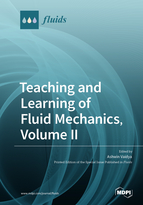Teaching and Learning of Fluid Mechanics, Volume II
A special issue of Fluids (ISSN 2311-5521).
Deadline for manuscript submissions: closed (10 March 2021) | Viewed by 59754
Special Issue Editor
Interests: mathematical fluid mechanics; non-linear partial differential equations; hydrodynamic stability; non-Newtonian fluid mechanics; fluid–structure interaction; experimental fluid mechanics; philosophy of science
Special Issues, Collections and Topics in MDPI journals
Special Issue Information
Dear Colleagues,
This Special Issue is devoted to the various ways of teaching and learning about fluid mechanics. Fluid mechanics occupies a privileged position in the sciences; it is taught in various science departments including physics, mathematics, mechanical, chemical and civil engineering and environmental sciences, each highlighting a different aspect or interpretation of the foundation and applications of fluids. While scholarship in fluid mechanics is vast, expanding in the areas of experimental, theoretical and computational fluid mechanics, there is little discussion among scientists about the different possible ways of teaching this subject. Our Special Issue is therefore devoted to this very theme. We think there is much to be learned, for teachers and students alike, from an interdisciplinary dialogue about fluids. We invite all kinds of articles, including research on the pedagogical aspects of fluid mechanics, communications, discussions, essays, letters, short notes and tutorials at the undergraduate or graduate level. Articles on historical aspects of fluids, novel and interesting experiments or theoretical calculations which can convey complex ideas in creative ways are welcome. Research articles are not appropriate for this issue. However, research presented in a simple manner and contextualized within the framework of the fluid mechanics curriculum may be acceptable.
All articles will undergo a rigorous peer review process.
Prof. Dr. Ashwin Vaidya
Guest Editor
Manuscript Submission Information
Manuscripts should be submitted online at www.mdpi.com by registering and logging in to this website. Once you are registered, click here to go to the submission form. Manuscripts can be submitted until the deadline. All submissions that pass pre-check are peer-reviewed. Accepted papers will be published continuously in the journal (as soon as accepted) and will be listed together on the special issue website. Research articles, review articles as well as short communications are invited. For planned papers, a title and short abstract (about 100 words) can be sent to the Editorial Office for announcement on this website.
Submitted manuscripts should not have been published previously, nor be under consideration for publication elsewhere (except conference proceedings papers). All manuscripts are thoroughly refereed through a single-blind peer-review process. A guide for authors and other relevant information for submission of manuscripts is available on the Instructions for Authors page. Fluids is an international peer-reviewed open access monthly journal published by MDPI.
Please visit the Instructions for Authors page before submitting a manuscript. The Article Processing Charge (APC) for publication in this open access journal is 1800 CHF (Swiss Francs). Submitted papers should be well formatted and use good English. Authors may use MDPI's English editing service prior to publication or during author revisions.
Keywords
- Flow visualization
- Experimental studies
- Computer simulations
- Mathematical modeling
- Fluid flow in the arts
- History of fluids
- Undergraduate education
- Applications of fluids






